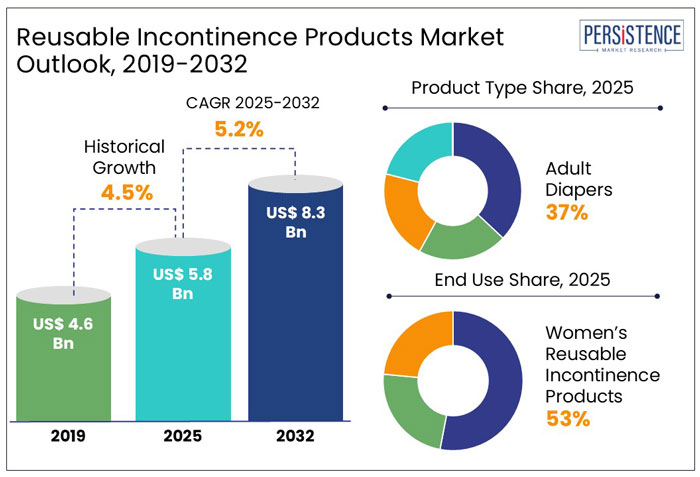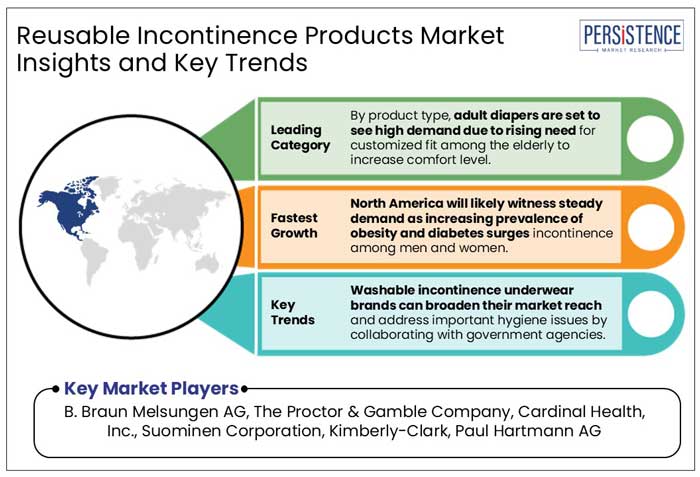ID: PMRREP33169| 190 Pages | 21 Feb 2025 | Format: PDF, Excel, PPT* | Healthcare

The global reusable incontinence products market size is anticipated to reach a value of US$ 5.8 Bn in 2025 and is set to witness a CAGR of 5.2% from 2025 to 2032. The market will likely attain a value of US$ 8.3 Bn in 2032.
In a bustling city, tired of constant diaper changes, Annie, a new mother, holds her infant in the early morning hours. She feels uneasy about the heaps of disposables in her trash can. A question pops up in her head- are these really the ideal choice for her baby’s delicate skin and the planet?
In another part of the city, John, a retired professor, hesitates before stepping outside for a walk. It has been difficult to manage incontinence, and disposable products are wasteful, costly, and uncomfortable. Something more discrete, breathable, and reusable is what he hopes for.
They are not alone. Millions of people are searching for a more sustainable way to manage incontinence. Reusable incontinence products are hence being introduced by several companies globally to blend sustainability, cost-effectiveness, and comfort in ways disposables never could. From fashionable, machine-washable underwear for adults to highly absorbent cloth diapers for infants, innovation is propelling a trend toward products that are more environmentally and human-friendly.

Key Highlights of the Reusable Incontinence Products Industry
|
Global Market Attributes |
Key Insights |
|
Reusable Incontinence Products Market Size (2025E) |
US$ 5.8 Bn |
|
Market Value Forecast (2032F) |
US$ 8.3 Bn |
|
Projected Growth (CAGR 2025 to 2032) |
5.2% |
|
Historical Market Growth (CAGR 2019 to 2024) |
4.5% |
Distributors Adapted to Rising Home Care Demand by Strengthening Direct-to-consumer Sales
In the historical period from 2019 to 2024, the global reusable incontinence products industry witnessed a CAGR of 4.5%. There has historically been a divide between the institutional and consumer markets for incontinence products, and that the key shift in long-term care, especially for senior citizens, has been the increase in home care.
Even though people living at home received home care from professional agencies, they were increasingly purchasing incontinence products themselves. As a result, distributors, who had long-standing relationships as medical supply distributors with care providers, were being compelled to market directly to consumers at home.
Large-scale medical supply distributors hence developed their e-commerce direct-to-consumer models. Brands began offering value not just by providing products on the website for buying with ease, but they delivered some hand holding in choosing the right product. Consumers had difficulty in selecting the ideal item in terms of performance and fit when they were given a wide range of products to choose from. This helped e-commerce distributors to develop strong relationships directly with consumers.
Because Market, a key online incontinence brand, for example, extended its digital community by starting Men’s and Women’s Facebook Incontinence Support Groups. These brought more people together to initiate support, share tips, and personal stories.
Greenhouse Gas Reduction to become a Key Focus in Incontinence Product Manufacturing through 2032
From 2025 to 2032, the reusable incontinence products industry is likely to showcase a CAGR of 5.2%. The market is anticipated to undergo a transformational shift as modern consumers and companies alike emphasize sustainability without compromising on performance or comfort. Reusable products are projected to gain impetus as people are looking for skin-friendly, eco-friendly, and cost-effective alternatives to conventional disposable products.
Leading this charge, Attindas Hygiene Partners has launched its reduced carbon emissions adult incontinence protective underwear across Europe. It uses ultrasonic bonding instead of conventional glue adhesive. The company has also successfully lowered greenhouse gas emissions, including carbon dioxide, to lower its environmental impact. Attindas' previous successful launches in North America and Spain are being built upon with this technical investment.
Growth Drivers
Demand to Surge among Individuals Suffering from Bladder Control Issues due to Obesity and Diabetes
Increasing prevalence of neurological disorders, obesity, and diabetes is anticipated to lead to bladder control issues among various age groups. As awareness about long-term incontinence management surges, consumers are searching for reusable products that offer high comfort and protection without irritating the skin.
Consumers nowadays seek incontinence products that blend easily with their lifestyles. Modern reusable products are mainly designed to look and feel like regular undergarments, providing comfort, style, and discretion. This inclination is specifically appealing to younger adults managing incontinence because of medical issues, sports injuries, and postpartum recovery. Key companies are projected to launch highly durable products to offer better skin protection and improved fit.
Drying Time and Bulkiness May Pose Challenges for Reusable Products
Washable adult diapers are designed to be highly absorbent. As a result, they may take longer to dry after washing, particularly if tumble drying is unsafe. Brands need to focus on providing innovative products that can be tumble dried without hindering their waterproof qualities.
Some of the overnight tape-tab style diapers may be uncomfortable and bulky for active adults. They may not be ideal for people with light incontinence. Cloth-based incontinence products may not offer as much absorbency as disposable products. As these require cleaning in-between uses, individuals with busy lifestyles may find these inconvenient.
Collaborations with Health Organizations to Create New Growth Avenues
A key opportunity in the global market lies in strategic partnerships that support sustainability, hygiene, and health, specifically for vulnerable populations. A notable example of this strategy is the renewal of partnership between UNICEF and Kimberly-Clark’s Huggies brand.
It aims to ensure newborns in Latin America and the Caribbean have access to essential care and services for a healthy start in life. This partnership highlights the significant role of hygiene brands in boosting social impact, an opportunity that reusable incontinence product manufacturers can leverage.
Washable incontinence underwear brands can broaden their market reach and address important hygiene issues by collaborating with government agencies, private organizations, and health groups. This is particularly important in underdeveloped countries where access to sustainable and reasonably priced incontinence care is limited. Brands can also access new consumer segments, finance opportunities, and endure brand loyalty by positioning their products as not only environmentally friendly but also necessary for improved health outcomes.
Product Insights
Adjustable Fit and High Absorbency to Fuel Adoption of Reusable Adult Diapers
By product, the adult diapers segment is anticipated to hold a reusable incontinence products market share of 37% in 2025. Diapers accommodate a variety of body shapes and sizes with adjustable tabs that enable a secure and customized fit.
For individuals looking for a customized fit, this adaptability is a key factor as it improves comfort and prevents leaks. These are also being used by the elderly to reduce the risk of infections occurring from the use of public restrooms during travel.
Diaper briefs are becoming immensely popular among the elderly, who frequently struggle with incontinence, as these are convenient and appropriate for caregivers. The need for more absorbency in addition to other incontinence solutions for those who need extra protection is what pushes demand for reusable underpads.
End Use Insights
Women Suffering from Pregnancy and Menopause-related Incontinence to Propel Demand for Reusable Solutions
In terms of end use, the women’s reusable incontinence products segment will likely hold a share of 53% in 2025. Women are usually more prone to developing incontinence owing to pregnancy and childbirth, which often weakens the pelvic floor muscles that support the bladder.
Constant changes in hormones during menopause further causes tissue thinning in the urethra, as well as changes in anatomical structure of the urinary tract. It makes them more susceptible to pressure on the bladder from lifting or coughing. These can contribute to urine leakage when bladder control is compromised, thereby creating a surging need for reusable incontinence products.
In kids, bedwetting or nocturnal enuresis can occur even if they have no prior history of bladder or lower urinary tract problems. When sphincter control is attained by the age of five, primary nocturnal enuresis, which affects around 90% of kids, usually goes away.
Kids may experience urgency with or without urge incontinence, often known as overactive bladder syndrome, which frequently happens during the day and/or at night. Boys are twice as likely as girls to have Urinary Incontinence (UI).
Male incontinence is frequently a symptom of an underlying medical condition, such as an enlarged prostate, but it can also be an indication of aging. Those with mild stress incontinence can usually manage their symptoms with reusable briefs and incontinence pads, especially at night. Companies worldwide are likely to invest in the development of sustainable products for all end users so that each can manage their challenges associated with incontinence with ease.

Asia Pacific Reusable Incontinence Products Market
India’s Growing Infant Population Supports Baby Diaper Demand While Japan Sees a Shift to Adult Use
In Asia Pacific, Japan is projected to be the target market for adult reusable incontinence pants. Due to a low birth rate and shifting lifestyles, Japan's population is aging quickly.
Even though the country’s government has taken several measures like providing financial assistance to young couples and offering child allowance, to deal with depopulation, these have not been very effective. Hence, with rising geriatric population, reusable adult diapers are being used more by older people than by babies. This is compelling diaper makers in the country to shift toward the adult segment for generating revenue.
In March 2024, for example, Oji Holdings, a leading diaper company, announced that its subsidiary, Oji Nepia, produces around 400 million infant diapers annually. However, since 2001, production has been declining. It plans to begin manufacturing baby diapers in Indonesia and Malaysia where it anticipates steady demand. Unicharm, one of the most prominent diaper companies in Japan, stated that its sales of adult diapers have exceeded those for infants.
In India, on the other hand, the scenario is opposite. The country has one of the highest birth rates worldwide. In 2021, its birth rate was 17.4 births per 1,000 people, as per World Bank. A higher infant population is anticipated to naturally raise demand for baby hygiene products, including reusable bladder leak pads and diapers. In addition, as caring for the environment is no longer a choice but a necessity in India due to increasing pollution, reusable cloth diapers are gaining traction.
North America Reusable Incontinence Products Market
Market Players in the U.S. Target Underserved Consumers with High-absorbency Reusable Products
North America is anticipated to hold a share of 33% in the global market in 2025. Even though old age is considered a key market growth driver in the region, a few common conditions like diabetes, obesity, and childbirth are set to raise the chances of incontinence among individuals of all ages.
In the U.S. reusable incontinence products market, in terms of both volume and value, the moderate/heavy incontinence segment, which includes products marketed for moderate to severe incontinence symptoms, slightly exceeded the light incontinence segment in 2022. Expansion was aided by several focused developments that improved performance, comfort, and variety for customers with heavy incontinence. They are often stigmatized and underserved in comparison to those with lighter symptoms.
Several U.S.-based companies are also striving to extend their position in Canada to gain a competitive edge. They are focusing on providing easy access to their products to all strata of the society. U.S.-based NorthShore Care Supply, for example, extended its presence in Canada in 2021. A range of NorthShore products, including the brand's iconic MEGAMAXTM tab-style briefs with maximum absorbency, protective underwear GoSupreme, and other ‘reassuringly strong’ items, are now available via Canada-based direct-to-home sellers Healthwick Canada and AgeComfort.
Europe Reusable Incontinence Products Market
Urge to Act Campaign Pushes for Better Access to Sustainable Incontinence Products in Europe
In 2023, in Europe, the cost of continence care exceeded 40 Bn Euros, according to recent worldwide research on the economic impact of urine incontinence. These include the costs of products, such as continence pads, medical consultations, hospital admissions, incontinence-related absenteeism at work, and the environmental effect of incontinence care.
As per Persistence Market Research, even though continence care is common, serious, and has remedies, policies and laws in both EU member states and non-member European countries frequently overlook it. Professor Philip Van Kerrebroeck, co-chairman of the Policy Office of the European Association of Urology, has hence implemented the Urge to Act campaign. It aims to encourage policymakers to provide better access to products like reusable pads and diapers by keeping in mind sustainability goals.
Several companies are starting to introduce their innovative products across Europe to provide both high performance and cost-effectiveness. For example,
Launch of similar products in the market is projected to create novel opportunities across Europe.
The global reusable incontinence product market is highly competitive with the presence of several large-, medium-, and small-scale companies. They are striving to launch innovative products with novel features to remain competitive.
Manufacturers are working to enhance absorbency levels, odor control, skin friendliness, discretion, and breathability when creating new products that cater to a variety of end users. This is owing to rising awareness of varying incontinence conditions, normalization of incontinence, and easy access to products. A few other emerging companies are focusing on providing eco-friendly products made with sustainable ingredients to reduce carbon footprint.
Key Industry Developments
The market is set to reach a value of US$ 5.8 Bn in 2025.
Adult diapers are the most popular reusable incontinence product worldwide.
In India, patients undergoing surgical procedures related to bladder, colon, or prostate are set to use reusable incontinence products.
The industry is projected to witness a CAGR of 5.2% through 2032.
B. Braun Melsungen AG, The Proctor & Gamble Company, and Cardinal Health, Inc. are the leading brands.
|
Report Attributes |
Details |
|
Historical Data/Actuals |
2019 - 2024 |
|
Forecast Period |
2025 - 2032 |
|
Market Analysis Units |
Value: US$ Bn/Mn, Volume: As applicable |
|
Geographical Coverage |
|
|
Segmental Coverage |
|
|
Competitive Analysis |
|
|
Report Highlights |
|
|
Customization and Pricing |
Available upon request |
By Product Type
By End Use
By Distribution Channel
By Region
Delivery Timelines
For more information on this report and its delivery timelines please get in touch with our sales team.
About Author